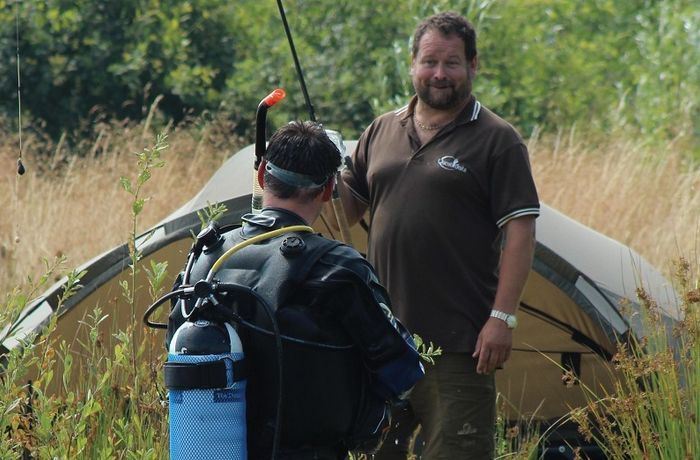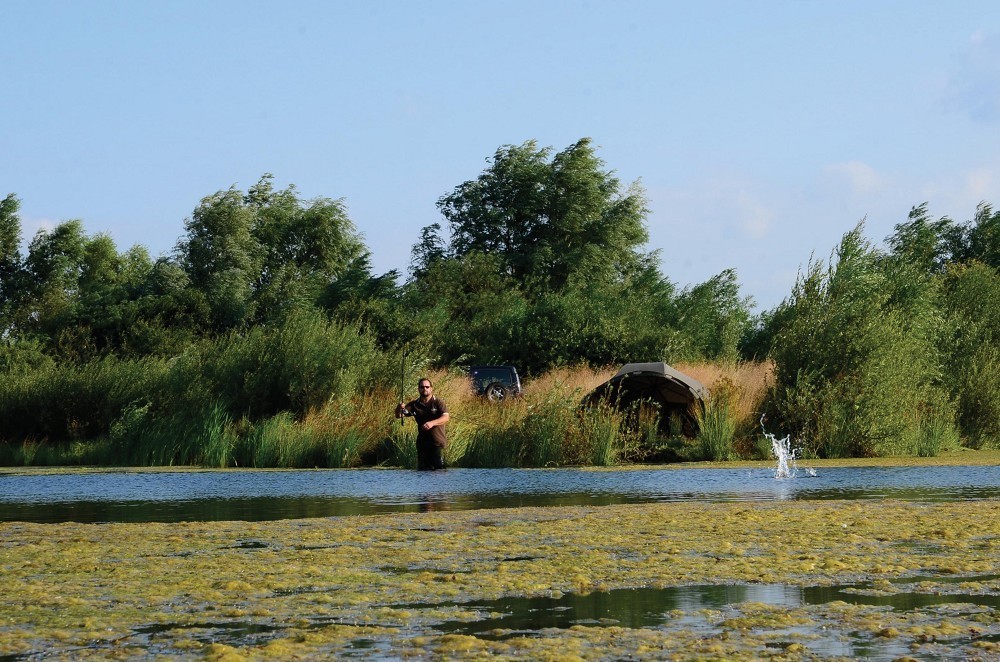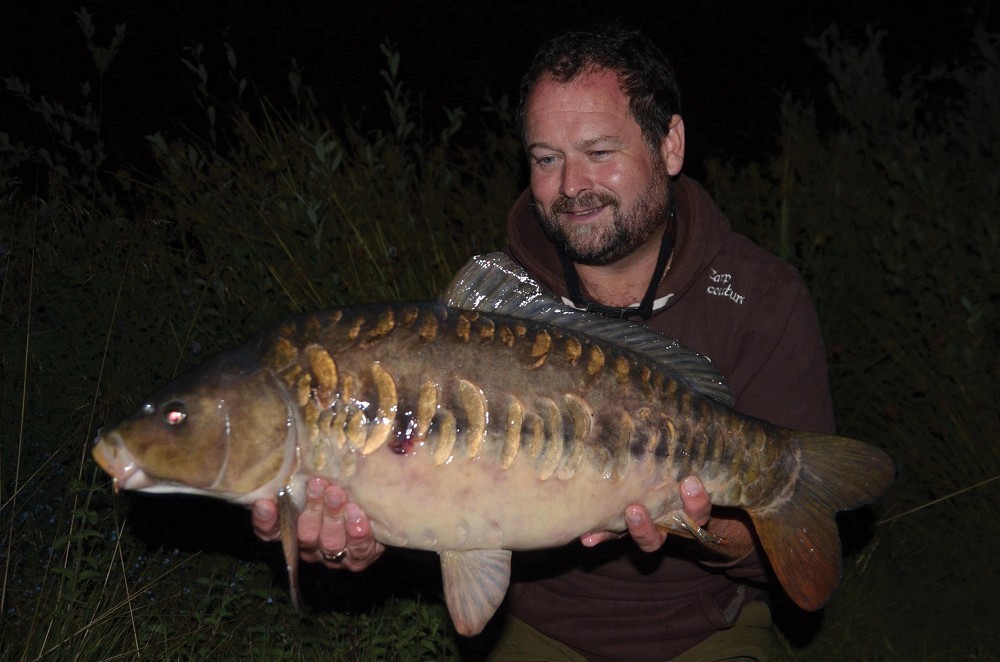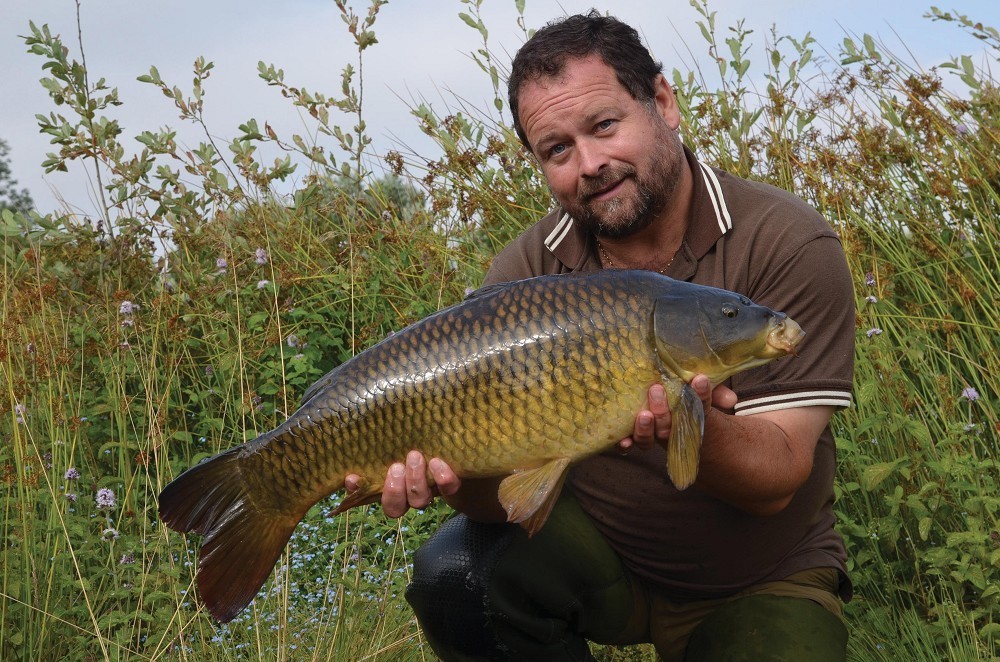Below the Surface: Shaun Harrison
It's the turn of carp fishing veteran, Shaun Harrison: a no bull, no hype, just 'solid angling' type of chap

Shaun Harrison is a no-nonsense type of angler. No bullshit, no hype. “Just solid angling” as Pete Regan would put it. He doesn’t get caught up in trends (he’s never used a Chod Rig); he has exceptional knowledge of bait – in fact he’s built up his own highly respectable bait company, Quest Baits over the past ten years. He’s fished all across the world and been involved with the tackle trade for the past 34 years. He’s clearly a ‘been there, done that, got the full winter suit complete with Baffins boots’. So to all intents and purposes this is going to be one exceptional Below The Surface, not for the errors we think we’ll see but more for a 10/10 performance; the equivalent to 180 in darts or an albatross in golf.
The lake we’re at today is a newly acquired one for the BCSG – an organisation which Shaun is heavily involved with. It’s an interestingly shaped lake, containing dozens and dozens of islands and little weedy bays, and according to Shaun who had fished the swim I’ve found him in today last weekend, it’s a very up and down lakebed too.
What’s most noticeable about this swim is how close-range all the fishing is – it’s literally under the ‘rod tips’ type of stuff, so I was keen to find out where Shaun was going to be placing his rods to they didn’t ‘cut’ one another off; he’s clearly doing it right if last weekend’s result was anything to go by: five bites, four fish landed.
“The left-hand rod is dropped just down the left-hand side of the swim, next to some floating algae and I guess in about 9ft of water. I’ve had a little drag around with the lead and it seems pretty clear; there’s the odd bit of Canadian Pondweed and other types of weed but it’s not too bad,” Shaun tells me. His middle rod, because he doesn’t want too much line out, is dropped directly out in front of the swim, just on the back of the weed again like the left-hander. The right-hand rod has been cast to the outside of the bay he’s fishing into. Here there’s a series of bars that run down the lake and seeing as there’s a good wind blowing in here at the moment, Shaun feels there’ll be plenty of oxygen coming around the side of these bars so he’s dropped one there. Unlike the left and middle rods which he predicts are “in around 9ft of water”, this right-hand rod is fished in a deepish gully of around 12ft.
It all made sense, but I was intrigued why Shaun had decided to fish his middle rod directly in from of the swim as this is something you rarely see anyone else do.
 The right-hand rod was fished slightly further out than the other two in 12ft of water and just like all three rods was fished with a reverse combi rig and had a pop-up hookbait attached. The middle rod was placed directly in front of the swim, just at the bottom of the shelf and again in 9ft of water. This rod was fished with a pop-up. The left-hand rod was positioned down to the left, just off a weedbed. Shaun predicted this would be in 9ft of water and used a wafter hookbait on this rod.
The right-hand rod was fished slightly further out than the other two in 12ft of water and just like all three rods was fished with a reverse combi rig and had a pop-up hookbait attached. The middle rod was placed directly in front of the swim, just at the bottom of the shelf and again in 9ft of water. This rod was fished with a pop-up. The left-hand rod was positioned down to the left, just off a weedbed. Shaun predicted this would be in 9ft of water and used a wafter hookbait on this rod.“It’s the most natural place for a carp to find a boilie,” he tells me. “Everyone takes their bait off and throws it in the edge but most anglers who fish in the margins go one way or the other but never directly in front of the swim.” How very true.
As we’ve come to learn over the eight years we’ve been doing Below The Surface, when you see weed, double, sometimes triple the amount you think is there, but is this the case with the spots Shaun’s picked today?
“When I had a quick cast about with a bare lead I was bringing back various bits; from six-foot long straggly weed to a bit of Canadian and silkweed too. The middle rod has bumped down lovely, so I’m pretty certain that’s on sandy gravel unless I’ve hit a mussel as that went down really hard. I think the left-hand rod is on sandy/hard mud – a really firm bottom, and the right-hand rod is going to be a little bit softer – I suspect there’ll be a fine layer of silt on the bottom there, but in terms of weed around the hookbait? I think it should be pretty clear.”
Shaun said to me at the start of this feature that he uses two rigs: a combi rig and a reverse combi rig, and for today’s “test” he’s opted for the latter: a soft braided main boom section and stiff hook section which he describes as a “very safe but lightweight bent hook”. Two of the rigs have pop-ups on, whereas the left-hand rod has a wafter hookbait. Shaun informs me that the fish in here haven’t been fished for an awful lot and, as such, he has found a lot of the time the carp don’t bolt off, so he’s hoping this stiff, acute angled pop-up hook section will cause them to prick themselves a bit more, causing them to bolt.
“In my mind, the most important element on this hooking arrangement is the soft Hair which really allows the hook to really upend,” Shaun informs me. “If you make the Hair from a continuation of the hooklink material, which is what most anglers do, you don’t get half as much movement on the hook. There’s a very stiff 22.5lb fluorocarbon section going to the hook which makes it like a longshank hook but without all the weight, and then a soft braided boom section is tied to this via the Albright Knot. The Hair is exiting roughly level with the point of the hook and the gape between the hook and the bait is about the diameter of the hookbait, around 15mm.”
The leads are all fished on quick-release clips and in terms of the size, Shaun’s made a bit of a compromise: “I normally like to use very small leads, around an 1.25oz, but there’s a bit of a wind blowing here and the surface scum is moving around a bit so I’m having to use 2oz leads just in case I get algae on the line which could move them.”
Being such a weedy swim, I was interested to know (a) how he was going to fish his lines – slack, semi slack or tight – and (b), how impressive he thought this bite indication would be.
“It won’t be perfect, but amongst weed that doesn’t worry me too much,” states Shaun as he sets his indicator to ‘half-mast’. “I’d imagine there’ll be sharp line angles down from the rods to the rigs on the left and middle rods, but there’s lots of things growing up off the bottom anyway so they shouldn’t look too out of place. I’m fishing semi slack lines with a good drop on the bobbins, so should a fish bump into the line, the bobbin will rise up and it’s not really tight on the fish. In terms of bite indication, because we’re fishing pretty close-range, I wouldn’t have thought very far; I’d be happy with three- or four-foot. As I’ve previously mentioned, I like to fish my bobbins at half-mast and I believe you get far improved bite indication fishing them this way rather than tight to the blank of the rod.”
When it came to baiting, Shaun was using just boilies, but there appeared to be two major differences between his boiled food and most other anglers. First off he was using Quest’s Magnum Duo which is the same bait but it comes in two different colours: brown and white. And secondly, these had been soaking in hemp juice overnight so they soften up a bit, and for those who read Shaun’s article entitled ‘Giving Boilies A Good Drink’ in the April edition will know, it also adds in masses and masses of attraction.
In terms of baiting patterns, he’s playing it by ear at the moment. It’s really hot right now so he’s not putting much bait in – around 100 boilies on one and less on the other two – however, he informs me he may top those levels up if he’s seeing fish.
“That’s the other benefit of soaking the baits in the hemp juice: once the fish get on it there’ll be flat spots coming to the surface, a bit like pellet fishing, so it’s easier to gauge whether to put more bait in or not. I also like to soak them as it softens them right down. I’m a firm believer in older carp having rotten teeth and as such they will struggle with very hard baits. They will of course eat them but it’s something I started doing on the Mangrove and the softer I made the baits, the bigger the average size of fish I was catching. It doesn’t always work like this, but the bigger fish tend to be the older carp and it just got the old brain cells going. I’ve not heard anyone else say it, but I’m pretty convinced on that.”
So there you have it: three rods, which from above the water look perfectly placed with beautifully tied rigs. Right, it’s over to you again, Hughesy…
Hughesy's bit
From above, the water looked crystal clear but as soon as I took my first glance below the surface I saw a daphnia cloud – the like of which I have never seen before. My own pool, Birchwood in Shropshire used to be incredibly rich, but this was something else. There were millions of bugs in the upper layers and I feel that this is partly what was keeping the water so clear. The scientific category for Daphnia as we know it is Zoo Plankton. They are tiny little animals which eat phyto plankton (the tiny strands of algae that are the base of the food chain) and in the water just below the Daphnia were short threads of algae were offering a tasty meal.
As I followed Shaun’s first line out, the upper layers were crystal clear once I had dipped below the bugs that were occupying the top foot where the water temperature and the light were providing a prolific feeding ground. By 3ft below the surface it was still clear and Shaun’s line snaked through a hidden snag tree but by 6ft down the larger and stronger algae had come into play and the water took on a green tinge. I followed the line to about 10ft deep where the water had turned a murky reddy brown colour. The soil/gravel in this region is red/brown and I have seen it before both on this complex of lakes and also not too far away at Kingsbury. The green light passing through the algae cloud turns brown when it hits the bottom and everything goes very, very dark, so dark in fact that the heat couldn’t penetrate down as well and from about 10ft in the gully the water was cold and dark. It wasn’t somewhere I felt the fish would be happy frequenting and certainly not somewhere I could find the rig so we gave up and returned to surface as visibility was too restricted.
The middle rod was easy to find as it was straight out in front of him. For a few yards directly in front of the swim there was a hefty bed of Canadian. The surface above it was covered in a raft of filamentous thread algae (candy floss to us carp anglers) but from below looking up, the algae raft wasn’t a problem. The Canadian was like a thick wall, but because the bottom dropped off very, very steeply, it ended abruptly so I would say that the wall of weed ended at 5-6ft depth and the clay-sided margin dropped steeply down to 10-12ft. The line was particularly hard to follow through the weed but once out I followed it almost vertically down to find the rig sat a few feet up the slope from the bottom, perfectly presented. Just to the side and a little higher than where Shaun’s rig was sat was a spot where the fish had clearly been rubbing. The stones were visible as the silt had been cleared off.
As it dropped down towards the lower part, some silt covering was present but the main amount was at the bottom. The lead had buried itself in the reddy brown silt and the rig was positioned nicely. There were a few baits in the area but most of the round balls had rolled to the bottom or got caught up on dips or obstacles on the way down.
Interestingly, Shaun was using two different types of boilies, a brown bait and a white bait, and the white bait seemed to be irresistible to caddis grubs and other critters that were lurking on the bottom. They were on it in a matter of minutes, but only the white stuff. Speaking to Shaun after, he said they were identical other than the colour but the bugs clearly found one more attractive than the other.
The other thing to note was that the baits rolled down the steep margins and ended up either caught up in dips or depressions on the shelf, by debris or at the bottom. One or two were caught up in the weed, but on the rod that was up the shelf, there wasn’t a lot of bait around it. Higher up and lower down, but not by!
As I popped back up to report and move on I couldn’t help but notice the sun was starting to set and the evening was turning to a golden glow. I’m usually out of the water by now so it was beautiful down below watching the roach shoals dart around above me as I watched a sunset from below the surface.
The left-hand rod was a similar situation to the middle, although it was a bit further out and as a result it was at the bottom of the shelf rather than up it. Being a balanced hookbait popped up just off the hook, it sat nicely on the silt at the bottom of the shelf with a few baits in the vicinity. Once again the lead had sunk into the silt but the hookbait sat proud. There was a little weed nearby which made the presentation even better. One thing that was a little obvious was the tubing, as the angle was so steep it was off the bottom by about three-inches. In the slightly murky water this would probably not matter and as the fish fed they would cloud it up even more.
Satisfied that Shaun was very well presented on the two rigs I had found, I put my money where my mouth was and suggested that both would be my favourites for a bite.
Morning proved my theory correct, although Shaun did actually have a bite on the rod I thought was too cold and gloomy. It sadly fell off so we shall never know what it was. The other two rods both produced a fish a piece so we had the benefit of not one but two baited areas to look at.
When I went down to see the first one, none of the bait from the previous day was there. The fresh stuff was still there and the rig was re-positioned perfectly for another bite but before I could take a shot of it I disturbed a cloud of silt and lost the moment. I could however feel where it was so I carried out the indication test and moved the rig no more than about a foot before I felt resistance from Shaun’s strike. It was under the rod tip by about 5yds so indication was expected to be half decent, and so it proved.
I then went on to the second rod which once again was at the bottom of the slope and being a little more careful this time as the silt disturbed very easily, I managed to get a shot of the rig. Once again it was well presented and looked to all intents and purposes like a freebie. The hooklink was well disguised and interestingly the hookbait was on the deck rather than popped up off the Hair.
What was inherently plain to see was the clouding in the water from the feeding fish. There was a lot of disturbed silt kicking around and the fish had clearly been active in the area quite recently. I couldn’t take a wide shot as a result of the clouding but you can see from the shot I took of the weed that it was pretty murky down there.
Shaun’s been round the track a fair number of times and catches a lot of fish by angling for them and using watercraft rather than the more modern ‘bait-and-smash’ approach. It was interesting that he chose to put his rods as close in as he did. Most anglers would have looked at the swim and maybe “put one down the edge” with the others out in the pond. He didn’t. He used watercraft and also experience to know that the margins were good spots and having been underwater in his swim showed he had undoubtedly picked the best spots from that swim.
Shaun's reflections
Highlight: “The way the rigs appear to be sitting. I’ve used those presentations for years and I’ve caught a few along the way, so I was guessing they would be okay but it’s the first time I’ve ever been able to see them in situ underwater so that was a result. Plus, sitting here last night, having seen the rigs were presented okay was quite a buzz too. It was also nice to put a couple of fish on the bank: one in the dark and one in the daylight. Unfortunately I lost one this morning, but it was nice to get a take on all three rods, particularly that right-hand rod as Rob had said I had zero chance of getting a bite from it!”
Lowlight: “Losing one, but that’s part and parcel of fishing. There was a lot of weed on the line so it was quite hard to keep in direct control of it. It wasn’t a major disappointment though. Although not really a ‘lowlight’, I must admit I didn’t expect the rig tubing to be off the bottom like that. I knew the tubing would stand out, but I haven’t got an issue with that, but I didn’t expect it to be lifted quite as much.”
Any big lesson learnt: “Nothing major, but another big highlight was seeing all those little critters and caddis on the my boilies; that shows the difference between baits – if you can get the natural stuff feeding on it, it’s then a natural attractor too. Oh, one final thing was how cold Rob found my 12ft spot (the right-hand rod). With the summer we’ve had so far, day after day of blistering sunshine you’d think that all that water would have been warmed by now but it clearly wasn’t. In 30ft I could understand, but not 12ft.”




